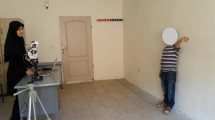Abstract
It is often overlooked in human-robot gestural interactions that, robot produce sound when they move. That aspect might be either beneficial or detrimental to the interaction, but it should be taken into account, especially in the context of robot-assisted therapy.
In this paper, we therefore considered sensory perception in the case of typically developing children and children with Autistic Spectrum Disorders and designed a pilot study with twenty participants to evaluate the impact the sound of actuators has on a rhythmic gestural interaction. Participants were asked to perform a waving-like gesture back at a robot in three different conditions: with visual perception only, auditory perception only and both perceptions. We analyze coordination performance and focus of gaze in each condition. Preliminary results indicate that the sound of actuators might be beneficial for children with autism and only slightly disruptive for typically developing children.
M. Jouaiti and E. Zehnder—These authors contributed equally.
Access this chapter
Tax calculation will be finalised at checkout
Purchases are for personal use only
Similar content being viewed by others
References
Bartlett, N.R., Bartlett, S.C.: Synchronization of a motor response with an anticipated sensory event. Psychol. Rev. 66(4), 203 (1959)
Bogdashina, O.: Sensory Perceptual Issues in Autism and Asperger Syndrome: Different Sensory Experiences-different Perceptual Worlds. Jessica Kingsley Publishers (2016)
Dunlap, K.: Reaction to rhythmic stimuli with attempt to synchronize. Psycholog. Rev. 17(6), 399 (1910)
Fraisse, P.: Auditory rhythms and visual rhythms. Ann. Psychol. 49, 21–42 (1948)
Fujimoto, I., Matsumoto, T., De Silva, P.R.S., Kobayashi, M., Higashi, M.: Mimicking and evaluating human motion to improve the imitation skill of children with autism through a robot. Int. J. Soc. Robot. 3(4), 349–357 (2011)
Gault, R.H., Goodfellow, L.D.: An empirical comparison of audition, vision, and touch in the discrimination of temporal patterns and ability to reproduce them. J. Gen. Psychol. 18(1), 41–47 (1938)
Goldfarb, W.: Receptor preferences in schizophrenic children. AMA Arch. Neurol. Psychiatry 76(6), 643–652 (1956)
Goldfarb, W.: Self-awareness in schizophrenic children. Arch. Gen. Psychiatry 8(1), 47–60 (1963)
Guneysu, A., Siyli, R.D., Salah, A.A.: Auto-evaluation of motion imitation in a child-robot imitation game for upper arm rehabilitation. In: The 23rd IEEE International Symposium on Robot and Human Interactive Communication, 2014 RO-MAN, pp. 199–204. IEEE (2014)
Hermelin, B., O’Connor, N.: Effects of sensory input and sensory dominance on severely disturbed, autistic children and on subnormal controls. Br. J. Psychol. 55(2), 201–206 (1964)
Hermelin, B., O’connor, N.: Psychological experiments with autistic children (1970)
Hidaka, S., Ide, M.: Sound can suppress visual perception. Tech. rep., Sci. Rep. 5, 10483 (2015)
Jaśkowski, P., Jaroszyk, F., Hojan-Jezierska, D.: Temporal-order judgments and reaction time for stimuli of different modalities. Psychol. Res. 52(1), 35–38 (1990)
Jouaiti, M., Henaff, P.: The sound of actuators: disturbance in human-robot interactions? In: Joint IEEE International Conference on Development and Learning and Epigenetic Robotics (ICDL-EpiRob), pp. 75–80 (2019)
Kolers, P.A., Brewster, J.M.: Rhythms and responses. J. Exper. Psychol. Hum. Percept. Perform. 11(2), 150 (1985)
Lachaux, J.P., Rodriguez, E., Martinerie, J., Varela, F.J., et al.: Measuring phase synchrony in brain signals. Hum. brain Mapp. 8(4), 194–208 (1999)
O’Connor, N., Hermelin, B.: Sensory dominance: in autistic imbecile children and controls. Arch. Gen. Psychiatry 12(1), 99–103 (1965)
O’Connor, N.: Visual perception in autistic children. Infantile autism: Concepts, characteristics and treatment. London: Churchill Livingstone (1971)
Ornitz, E.M., Ritvo, E.R.: Perceptual inconstancy in early infantile autism: the syndrome of early infant autism and its variants including certain cases of childhood schizophrenia. Arch. Gen. Psychiatry 18(1), 76–98 (1968)
Pandey, A.K., Gelin, R.: A mass-produced sociable humanoid robot: pepper: the first machine of its kind. IEEE Robot. Autom. Mag. 25(3), 40–48 (2018)
Posner, M.I., Nissen, M.J., Klein, R.M.: Visual dominance: an information-processing account of its origins and significance. Psychol. Rev. 83(2), 157 (1976)
Renshaw, S.: The errors of cutaneous localization and the effect of practice on the localizing movement in children and adults. Pedagog. Seminary J. Gen. Psychol. 38(1–4), 223–238 (1930)
Repp, B.H., Penel, A.: Auditory dominance in temporal processing: new evidence from synchronization with simultaneous visual and auditory sequences. J. Exper. Psychol. Hum. Percept. Perform. 28(5), 1085 (2002)
Schopler, E.: Early infantile autism and receptor processes. Arch. Gen. Psychiatry 13(4), 327–335 (1965)
Srinivasan, S.M., Lynch, K.A., Bubela, D.J., Gifford, T.D., Bhat, A.N.: Effect of interactions between a child and a robot on the imitation and praxis performance of typically devloping children and a child with autism: A preliminary study. Percept. Motor Skills 116(3), 885–904 (2013)
Suteerawattananon, M., Morris, G., Etnyre, B., Jankovic, J., Protas, E.: Effects of visual and auditory cues on gait in individuals with parkinson’s disease. J. Neurolog. Sci. 219(1–2), 63–69 (2004)
Vroomen, J., Gelder, B.D.: Sound enhances visual perception: cross-modal effects of auditory organization on vision. J. Exper. Psychol. Hum. Perception Perform. 26(5), 1583 (2000)
Welch, R.B.: Meaning, attention, and the unity assumption in the intersensory bias of spatial and temporal perceptions. In: Advances in psychology, vol. 129, pp. 371–387. Elsevier (1999)
Zaporozhets, A.: The origin and development of the conscious control of movements in man. In: Recent Soviet Psychology. Liveright New York (1961)
Acknowledgements
We thank all the children and parents who willingly took part in this study and filled in so many questionnaires.
Author information
Authors and Affiliations
Corresponding author
Editor information
Editors and Affiliations
Rights and permissions
Copyright information
© 2022 The Author(s), under exclusive license to Springer Nature Switzerland AG
About this paper
Cite this paper
Jouaiti, M., Zehnder, E., Charpillet, F. (2022). The Sound of Actuators in Children with ASD, Beneficial or Disruptive?. In: Cavallo, F., et al. Social Robotics. ICSR 2022. Lecture Notes in Computer Science(), vol 13818. Springer, Cham. https://doi.org/10.1007/978-3-031-24670-8_4
Download citation
DOI: https://doi.org/10.1007/978-3-031-24670-8_4
Published:
Publisher Name: Springer, Cham
Print ISBN: 978-3-031-24669-2
Online ISBN: 978-3-031-24670-8
eBook Packages: Computer ScienceComputer Science (R0)




